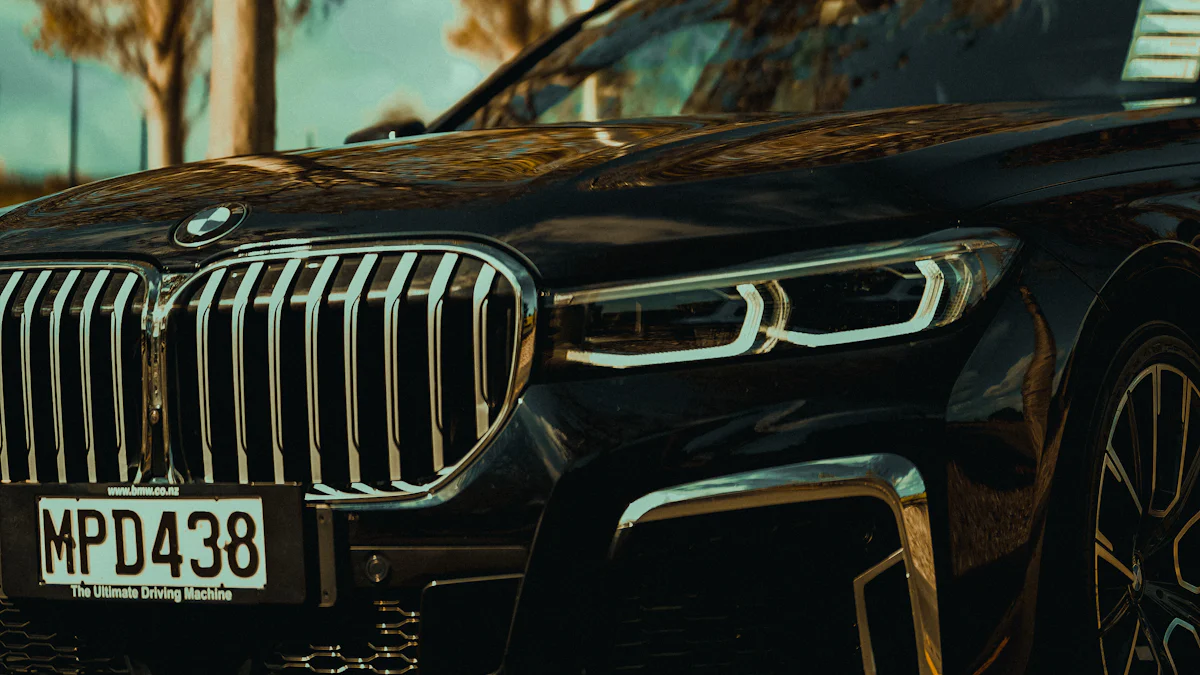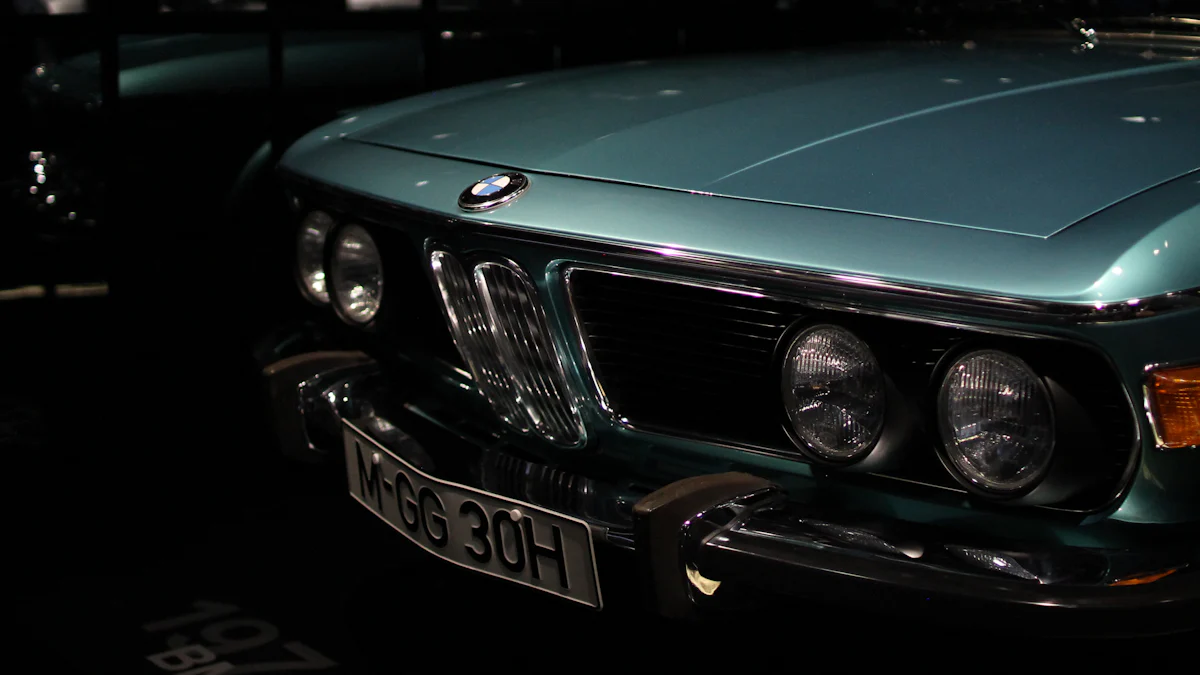BMW’s Controversial Grilles: A Design Revolution

BMW’s iconic kidney grill has been a defining feature of its cars for nearly 90 years. Recently, though, the introduction of massive BMW grills has sparked heated debates. Some see these controversial BMW grills as bold and innovative, while others view them as a departure from BMW’s classic elegance. The grill, once a hallmark of tradition, now challenges your perception of modern automotive design. Whether you admire or criticize it, this design evolution forces you to question how far a brand should go to stand out in a competitive market.
Key Takeaways
BMW’s oversized kidney grilles are designed to create a strong visual identity, making the brand instantly recognizable in a competitive market.
The new grille designs blend tradition with modernity, drawing inspiration from historical styles while pushing the boundaries of automotive aesthetics.
Despite mixed reactions, the bold design choices have proven effective, with models like the 4-Series experiencing steady demand and contributing to increased sales.
The grilles serve functional purposes, enhancing airflow for critical components, which underscores BMW’s commitment to innovation and performance.
Social media has amplified the debate around the grilles, showcasing both criticism and support, and keeping BMW at the forefront of automotive conversations.
BMW’s willingness to embrace controversy reflects its strategy to challenge norms and redefine luxury and performance in the automotive industry.
The evolution of the kidney grille symbolizes BMW’s forward-thinking approach, ensuring that its designs remain relevant and impactful in a rapidly changing market.
BMW’s Official Rationale Behind the Controversial Kidney Grilles
Insights from BMW Designers and Executives
When you look at BMW’s bold kidney grilles, you might wonder, “Why such a dramatic change?” According to Adrian van Hooydonk, Senior Vice President of Group Design at BMW, and Domagoj Dukec, Head of BMW Design, the answer lies in standing out. They’ve emphasized that the oversized grilles are not just about aesthetics but about creating a strong visual identity. In their words, the grille is a statement—a way for BMW to remain instantly recognizable in a crowded market.
BMW’s design team believes that innovation requires boldness. The kidney grille, which has been a hallmark of BMW for nearly 90 years, has evolved to reflect the brand’s forward-thinking philosophy. The larger size and upright positioning of the grille on models like the 4 Series and iX aim to make a lasting impression. As Pieter Nota, Member of the Board of Management at BMW AG, explained, the new designs embody BMW’s DNA while pushing boundaries. This approach aligns with BMW’s history of taking risks to redefine automotive styling.
Beyond its visual impact, the grille serves functional purposes. Its large surface area allows airflow to cool critical components like the radiator and brakes. This blend of form and function ensures that the grille isn’t just a design element but a vital part of the car’s performance.
“The new BMW 4 Series Coupé embodies the essence of the BMW brand. It is a forward-looking interpretation of BMW’s long-established DNA.” – Pieter Nota, BMW AG Board Member
Balancing Tradition with Modernity in the BMW Grill Design
BMW’s kidney grille has always been a symbol of tradition. From the slim vertical designs of the 1930s to the wide, low variations of the 1970s, the grille has evolved while staying true to its roots. However, the latest designs challenge this balance. By introducing massive grilles, BMW aims to bridge the gap between heritage and modernity.
The design of the current BMW grill reflects this duality. For instance, the grille on the 3 Series combines classic elements like conjoined kidney shapes with modern touches such as a mesh structure. These updates ensure that the grille remains relevant in today’s market while honoring its legacy.
BMW also draws inspiration from its past to justify its bold choices. The large, upright grilles on models like the 4 Series harken back to iconic designs from the 1930s and 1970s. By referencing these historical precedents, BMW reinforces the idea that its current styling is not a departure but an evolution.
Still, the decision to enlarge the grilles wasn’t without controversy. Critics argue that the new designs disrupt the harmony of BMW’s styling. Yet, BMW sees this as a necessary step to differentiate itself. The brand acknowledges that polarizing designs spark conversation, which can ultimately strengthen its identity.
In the end, BMW’s approach to grille design reflects its commitment to innovation. By balancing tradition with modernity, the brand continues to push the boundaries of what’s possible in automotive design.
Public and Expert Reactions to BMW’s Grill Designs

Criticism from Automotive Enthusiasts and Experts
When BMW unveiled its larger-than-life kidney grilles on models like the 4 Series and iX, the backlash was immediate. Many enthusiasts felt the design strayed too far from the brand’s classic elegance. Critics argued that the oversized grilles disrupted the harmony of BMW’s overall styling. Some even described the new look as “cartoonish” or “overwhelming.” The internet buzzed with memes and harsh commentary, showcasing the strong reactions these designs provoked.
Automotive experts also voiced their disappointment. They questioned whether the bold design truly aligned with BMW’s reputation for refined luxury. For some, the grilles seemed more like a desperate attempt to stand out rather than a thoughtful evolution of the brand’s identity. One common critique was that the massive grilles overshadowed other design elements, creating an unbalanced aesthetic. Despite these concerns, BMW remained steadfast in its decision, defending the grilles as a necessary step toward innovation.
“Few car design decisions have sparked as much debate as BMW’s new kidney grilles. Love them or hate them, they’ve certainly made an impact.” – Automotive Design Journal
Support for the Bold Design Choices
Not everyone viewed the new grilles negatively. Some fans and industry insiders praised BMW for taking risks and pushing boundaries. They saw the oversized kidney grilles as a bold statement, one that set BMW apart in a crowded market. Supporters appreciated the brand’s willingness to embrace controversy, arguing that polarizing designs often lead to greater recognition and stronger brand identity.
The grilles also earned praise for their functionality. Their larger surface area improves airflow, enhancing the performance of critical components like the radiator and brakes. For many, this blend of form and function demonstrated BMW’s commitment to innovation. Fans of the design highlighted how the grilles created a striking visual signature, especially in low-light conditions. They believed the new look reinforced BMW’s position as a leader in luxury and performance.
The Role of Social Media in Shaping Perceptions
Social media played a significant role in amplifying the debate around BMW’s new grilles. Platforms like Instagram, Twitter, and Reddit became battlegrounds for opinions. Memes mocking the design went viral, while heated discussions unfolded in comment sections. The strong reactions showcased how deeply people felt about BMW’s design choices.
At the same time, social media also provided a platform for supporters to share their perspectives. Influencers and automotive enthusiasts posted photos and videos highlighting the grilles’ unique appeal. Some even argued that the controversy itself was a win for BMW, as it kept the brand in the spotlight. The online buzz, whether positive or negative, ensured that the new grilles remained a hot topic in the automotive world.
In the end, the debate over BMW’s kidney grilles reflects the power of design to evoke emotion. Whether you love or hate the new look, there’s no denying its impact. BMW has succeeded in sparking a conversation, one that continues to shape perceptions of the brand.
Impact of the Controversial Kidney Grilles on BMW’s Sales and Brand Identity
Sales Performance of Models Featuring the New Grilles
You might wonder if the bold design of BMW’s oversized kidney grilles has affected sales. Surprisingly, the numbers tell an interesting story. The BMW 4-Series, one of the most talked-about models featuring the new grille design, has seen steady demand. While some critics doubted its appeal, the market response suggests otherwise. The new BMW 4-Series has managed to capture attention, proving that polarizing designs can still drive interest.
BMW’s overall sales performance has been impressive. In the first quarter of 2021, BMW Group reported a 33.5% increase in global deliveries. This growth included a 36.2% rise in BMW unit sales, showcasing the brand’s ability to attract buyers despite—or perhaps because of—its daring design choices. Models like the 4-Series and the electrified iX have contributed to this success, demonstrating that innovation resonates with customers.
Interestingly, smaller models like the 2 Series also experienced a surge in popularity. The 2 Series saw a staggering 199.5% year-over-year sales increase, even outselling larger models like the X7 and the BMW 4-Series. This trend highlights how BMW’s diverse lineup, including vehicles with the controversial grille, continues to perform well across different segments.
Effects on BMW’s Brand Image and Customer Base
The introduction of the massive kidney grilles has undoubtedly sparked debate, but it has also reinforced BMW’s reputation for boldness. You might see this as a calculated risk—a move designed to strengthen the brand’s identity in a competitive market. By embracing controversy, BMW has positioned itself as a company unafraid to challenge norms.
For some customers, the new grilles symbolize innovation and confidence. These buyers appreciate the striking visual impact and the way the design sets BMW apart from its competitors. The new BMW 4-Series, with its prominent grille, has become a conversation starter, drawing attention to the brand’s forward-thinking approach.
However, not everyone feels the same way. Some long-time enthusiasts believe the oversized grilles stray too far from BMW’s classic elegance. This shift has led to mixed reactions within the customer base. While some embrace the change, others feel disconnected from the brand’s evolving aesthetic. Despite this, BMW’s willingness to polarize opinions has kept it in the spotlight, ensuring that its designs remain a topic of discussion.
Ultimately, the bold grille design reflects BMW’s commitment to staying relevant in a rapidly changing industry. Whether you love or hate the look, it’s clear that BMW’s strategy has succeeded in keeping the brand at the forefront of automotive design and innovation.
The Evolution of BMW’s Design Philosophy and the Future of the BMW Grill

Historical Context of BMW’s Bold Design Choices
BMW’s design journey has always been a fascinating mix of tradition and innovation. If you look back to the 1960s, you’ll notice how BMW alternated between major design overhauls and subtle evolutionary updates. The 3 Series models, for instance, showcased this balance perfectly. Each generation introduced fresh ideas while staying true to the brand’s core identity.
The kidney grille, a signature feature of BMW, has undergone significant transformations over the decades. In the 1960s and 1970s, the grilles were rigid and boxy, reflecting the design trends of that era. By the 1990s, BMW embraced more curved and rounded shapes, giving the cars a sleeker and more modern appearance. These changes weren’t just about aesthetics—they symbolized BMW’s ability to adapt to changing times while preserving its essence.
One of the most influential periods in BMW’s design history came under Chris Bangle, the visionary designer behind iconic models like the 7-Series, Z4, and 5-Series. His work in the early 2000s introduced bold, avant-garde elements that divided opinions but undeniably pushed the brand forward. This willingness to take risks laid the groundwork for the daring designs you see today, including the oversized kidney grilles on the new BMW 4-Series.
BMW’s design philosophy has always been about more than just following trends. It’s about creating vehicles that stand the test of time. The company’s future-focused strategy ensures that its cars, including the 4-Series, remain relevant for years to come. When you see a BMW on the road, whether it’s from the past or the present, you can instantly recognize its unique styling.
“Design is not just about making something look good. It’s about creating something that lasts.” – Chris Bangle
How the Grilles Reflect BMW’s Vision for the Future
The oversized kidney grilles on the new BMW 4-Series are more than just a bold design choice—they’re a statement about where BMW is headed. These grilles symbolize the brand’s commitment to innovation and its desire to stand out in a crowded market. By embracing controversy, BMW challenges you to rethink what luxury and performance should look like.
The design of the 4-Series grilles reflects a blend of heritage and forward-thinking. Their upright, prominent shape harks back to the classic BMW models of the 1930s, yet their size and detailing feel distinctly modern. This duality shows how BMW respects its past while looking ahead to the future.
Functionality also plays a key role in these designs. The larger surface area of the grilles improves airflow, enhancing the performance of critical components like the radiator and brakes. This focus on both form and function ensures that the grilles aren’t just eye-catching—they’re practical too.
Looking ahead, BMW’s design philosophy seems poised to become even more daring. The company’s recent shift toward avant-garde styling, seen in models like the 4-Series and iX, suggests that it’s willing to take risks to stay ahead of the curve. As the automotive industry moves toward electrification and autonomous driving, BMW’s bold approach could set new standards for what’s possible in car design.
In the end, the evolution of the BMW grill tells a story of a brand that refuses to stand still. Whether you love or hate the new BMW 4-Series, you can’t deny that its design sparks conversation. And in a world where standing out is more important than ever, that might just be BMW’s greatest achievement.
BMW’s controversial kidney grilles represent more than just a design choice—they symbolize a fearless leap into the future. By blending tradition with bold innovation, BMW challenges you to rethink what defines luxury and performance. These grilles, inspired by the brand’s rich history, also serve functional purposes, cooling vital components while reinforcing BMW’s identity.
This daring approach sparks admiration and criticism, but it keeps BMW at the center of automotive conversations. As the industry evolves, you might see other brands follow BMW’s lead, proving that bold risks can redefine the boundaries of design.
FAQ
What is the kidney grille on BMW vehicles?
The kidney grille is the iconic front grille design that defines BMW cars. Shaped like two kidneys placed side by side, it has become a signature feature that instantly identifies a BMW on the road.
How has the kidney grille evolved over time?
Since its debut in 1933, the kidney grille has undergone significant changes in size and details. While the basic kidney shape remains consistent, modern designs are more upright, wider, and seamlessly integrated into the front bumpers of BMW vehicles.
What functional purposes does the kidney grille serve?
The kidney grille isn’t just about aesthetics. It plays a vital role in cooling the engine bay by allowing airflow to reach the radiator, condenser, intercoolers, and front brakes. This ensures optimal performance while maintaining BMW’s distinctive brand identity.
Why is the kidney grille significant in BMW’s history?
The kidney grille has been a constant presence in BMW’s lineup since 1933. Over the decades, it has cemented itself as a core element of BMW’s identity, symbolizing the brand’s commitment to blending tradition with innovation.
What notable design changes has the kidney grille undergone?
Over its 90-year history, the kidney grille has seen many transformations. From slim vertical designs in the 1930s to the bold, oversized grilles of today, BMW has continuously adapted the grille to reflect changing trends and technologies while retaining its iconic shape.
How has the BMW grille evolved with new technologies?
As BMW embraces new propulsion technologies, such as electric powertrains, the grille’s design has also evolved. For example, the Vision Neue Klasse concept features illuminated dual kidney shapes, showcasing how the grille adapts to the absence of traditional cooling needs.
What makes the kidney grille a signature design element?
The kidney grille is more than just a design feature. It’s a visual signature that sets BMW apart from other brands. Its unique shape and placement at the front of the car make it one of the most recognizable elements in automotive design.
Why are the grilles on models like the 4 Series and iX so controversial?
The oversized grilles on models like the 4 Series and iX have sparked debate among enthusiasts. BMW argues that these bold designs harken back to earlier grille styles from the 1930s, blending heritage with a modern twist. While some see them as innovative, others view them as polarizing.
How does the kidney grille reflect BMW’s vision for the future?
The kidney grille represents BMW’s forward-thinking approach to design. By combining functionality with bold aesthetics, it reflects the brand’s commitment to innovation. Whether through larger dimensions or illuminated graphics, the grille continues to evolve as BMW redefines luxury and performance.
What changes have been made to the grille on recent BMW models?
Recent models like the 4 Series, iX, and Vision Neue Klasse showcase BMW’s willingness to push boundaries. The grilles on these vehicles feature larger dimensions, unique lighting elements, and seamless integration into the car’s overall design, signaling a bold step into the future.
